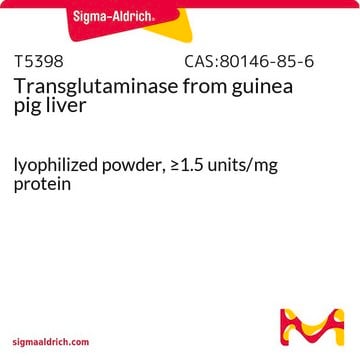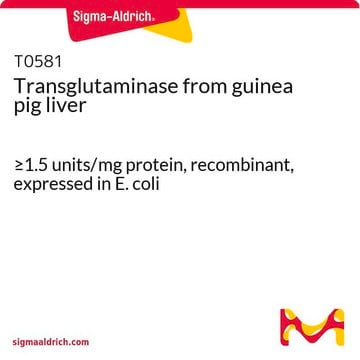SAE0159
Microbial Transglutaminase
lyophilized powder, ≥12 units/mg protein
Synonim(y):
Microbial Enzyme, Transglutaminase, Transglutaminase Enzyme
Zaloguj sięWyświetlanie cen organizacyjnych i kontraktowych
About This Item
Kod UNSPSC:
12352204
NACRES:
NA.54
Polecane produkty
Postać
lyophilized powder
Poziom jakości
aktywność właściwa
≥12 units/mg protein
Warunki transportu
dry ice
temp. przechowywania
−20°C
Opis ogólny
Transglutaminases (TG) are a family of enzymes that catalyze isopeptide bond formation. This bond formation occurs between the γ-carboxyamide group of glutamine and various primary amines (primarily the ε-amino group of lysine). The resulting intermolecular or intramolecular cross-linking of transglutaminase is highly stable and shows high resistance to proteolytic degradation. The transglutaminase crosslinking activity support the formation of blood clots , skin and hair. On the other hand, TG is now being implicated in Celiac disease as well as in Huntington and Parkinson diseases. Historically, Microbial transglutaminase has been heavily used in the food industry. Microbial TG is often preferred for newer applications (such as site-specific protein modification and antibody drug conjugation) due to its small molecular weight and lack of calcium dependency when compared to the mammalian forms.
Zastosowanie
Microbial Transglutaminase has been used for:
- Protein cross-linking & site-specific labeling
- Antibody Drug Conjugation
- 3D bioprinting bioink preparation
- Food related immunogenicity/pathogenicity related research
Cechy i korzyści
- Small (~38kDa) and calcium independent enzyme
- Highly purified lyophilized enzyme
- Consistent and reproducible activity
- Characterized for endotoxin content
Uwaga dotycząca przygotowania
For R&D use only. Not for drug, household, or other uses. Please consult the Safety Data Sheet for information regarding hazards and safe handling practices
Przechowywanie i stabilność
Store the freeze-dried product at –20 °C. It is recommended to store the reconstituted protein in working aliquots at –20 °C to avoid repeated freeze/ thaw cycles.
Hasło ostrzegawcze
Danger
Zwroty wskazujące rodzaj zagrożenia
Zwroty wskazujące środki ostrożności
Klasyfikacja zagrożeń
Resp. Sens. 1
Kod klasy składowania
11 - Combustible Solids
Klasa zagrożenia wodnego (WGK)
WGK 1
Temperatura zapłonu (°F)
Not applicable
Temperatura zapłonu (°C)
Not applicable
Certyfikaty analizy (CoA)
Poszukaj Certyfikaty analizy (CoA), wpisując numer partii/serii produktów. Numery serii i partii można znaleźć na etykiecie produktu po słowach „seria” lub „partia”.
Masz już ten produkt?
Dokumenty związane z niedawno zakupionymi produktami zostały zamieszczone w Bibliotece dokumentów.
Matthias Torsten et al.
Frontiers in pediatrics, 6, 389-389 (2019-01-09)
The enzyme microbial transglutaminase is heavily used in the food processing industries to ameliorate food qualities and elongate the products' shelf life. As a protein's glue, it cross-links gliadin peptides, creating neo-complexes that are immunogenic and potentially pathogenic to celiac
Marcela V Karpuj et al.
Neurochemistry international, 40(1), 31-36 (2001-12-12)
Transglutaminase (TGase) activity is increased in affected regions of brains from patients with Huntington's disease (HD). TGase activity is particularly elevated in the nucleus compared with the cytoplasm from these brains. Gamma-glutaminyl-lysyl cross-links have been detected in nuclear inclusions in
Istvan Vermes et al.
Movement disorders : official journal of the Movement Disorder Society, 19(10), 1252-1254 (2004-09-16)
Tissue transglutaminase (tTG) is activated during the apoptotic cell death cascade and plays a key role in the formation of apoptotic bodies. We found significant elevation of tTG concentration in the cerebrospinal fluid (CSF) of 54 patients with Parkinson's disease
Martin Griffin et al.
The Biochemical journal, 368(Pt 2), 377-396 (2002-10-09)
Transglutaminases (Tgases) are a widely distributed group of enzymes that catalyse the post-translational modification of proteins by the formation of isopeptide bonds. This occurs either through protein cross-linking via epsilon-(gamma-glutamyl)lysine bonds or through incorporation of primary amines at selected peptide-bound
Miaomiao Zhou et al.
Biofabrication, 11(2), 025011-025011 (2019-02-12)
Gelatin methacryloyl (GelMA) is a versatile biomaterial that has been shown to possess many advantages such as good biocompatibility, support for cell growth, tunable mechanical properties, photocurable capability, and low material cost. Due to these superior properties, much research has
Nasz zespół naukowców ma doświadczenie we wszystkich obszarach badań, w tym w naukach przyrodniczych, materiałoznawstwie, syntezie chemicznej, chromatografii, analityce i wielu innych dziedzinach.
Skontaktuj się z zespołem ds. pomocy technicznej









